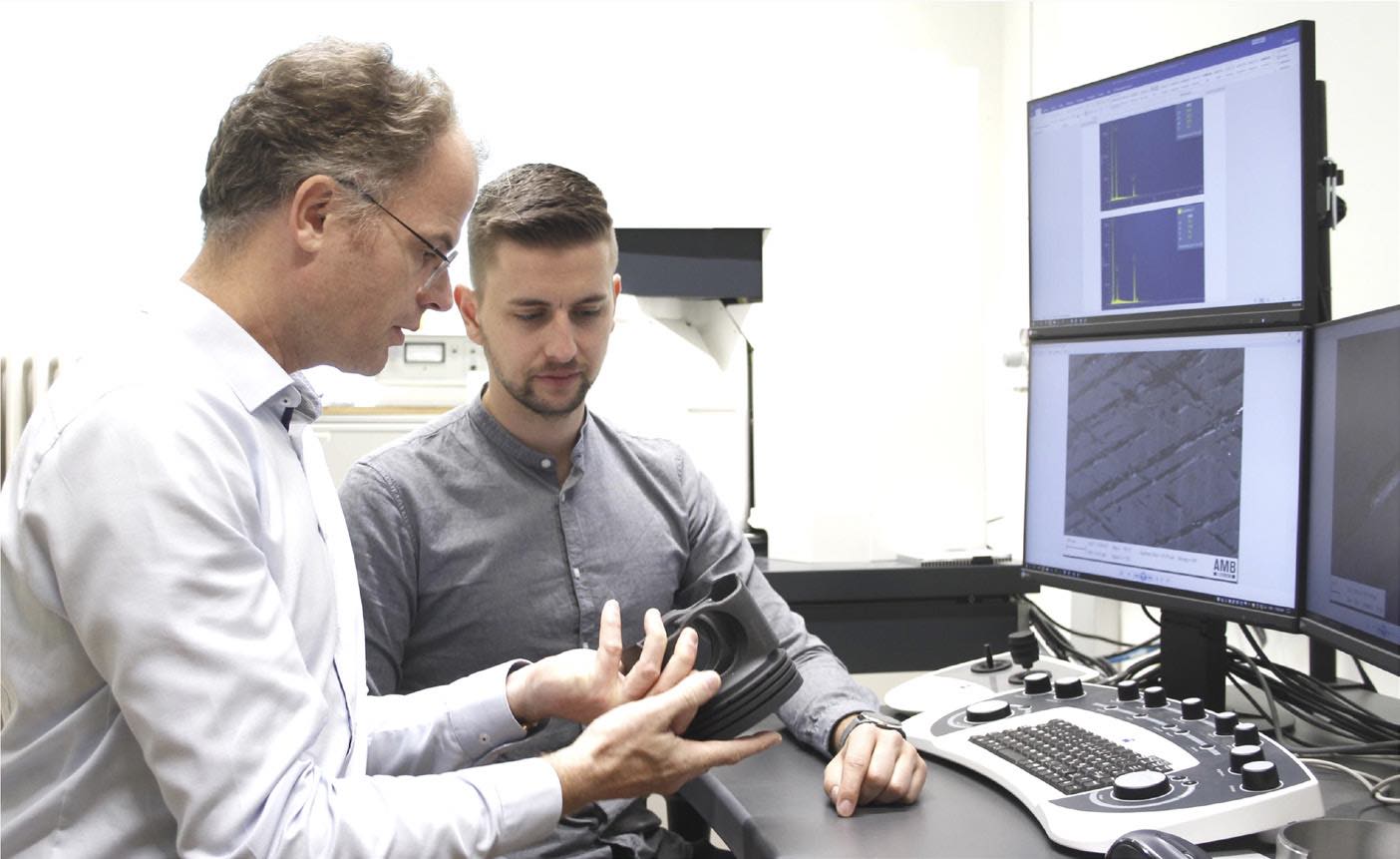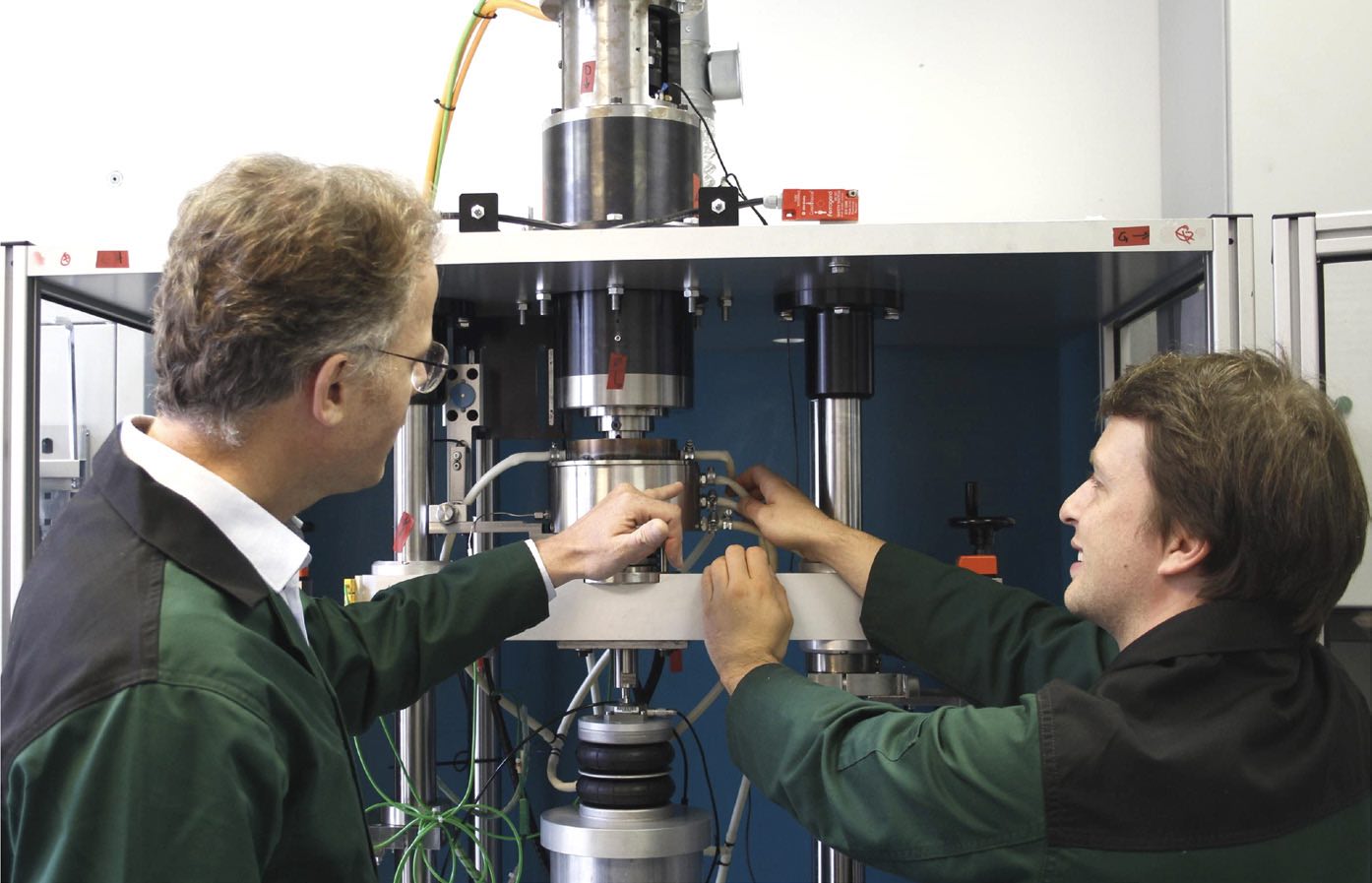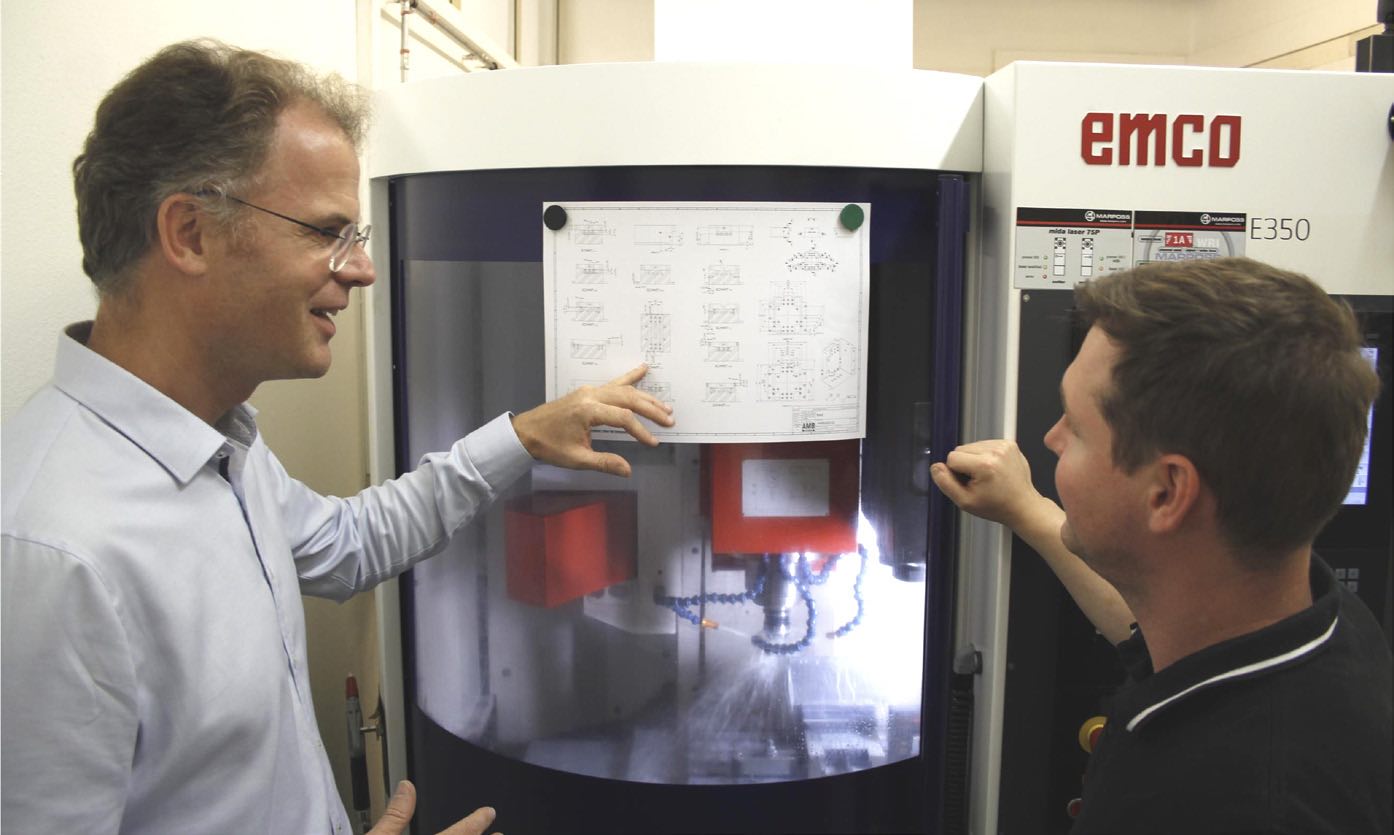TLT: What inspired you to pursue a career in engineering?
Grün: From my early childhood, I’ve been fascinated by the immense possibilities and vast potential of technology. Technical toys were a part of my everyday life. I had access to the first personal computers and enjoyed letting them interact with simple machines I designed and built, as well as automating those machines. This fascination grew during my teenage years and became the primary motivation behind my decision to pursue a technical degree, specifically in mechanical engineering. This enthusiasm for technology eventually led me to my current role as the head of the Institute of Mechanical Engineering, which involves a diverse range of technical responsibilities.
TLT: Why has the subject of tribology become a focus at the Institute of Mechanical Engineering?
Grün: This makes sense, especially when you consider that mechanical engineering also involves component design. In design, two aspects, among others, are of central importance, namely service life and efficiency. Our primary research focus is on fatigue analysis, which plays a crucial role in enabling lightweight designs. Pure fatigue failure applies only to free—i.e., non-contacting— surfaces. Think, for example, of a tooth root of a gear. However, if the failure location is in contact with another component, the failure is definitely not just a fatigue failure, but already a tribological task. To illustrate this, consider the example of a gear component. In such cases, tribological challenges arise at the gear flank or in its connection with the shaft. The gear example illustrates that fatigue analysis and tribology often go together in real life mechanical systems. Additionally, tribology serves as a technique to enhance efficiency by reducing friction and increasing the load capacity, often referred to as power density, of mechanical systems.
In addition, I must point out that the employed analytical technique also provides a second connection between fatigue and tribology. In the last three decades there has been a sharp increase in the need to understand the underlying failure processes in mechanical engineering. In the past, examination was often limited to the unaided eye or perhaps a magnifying glass. However, in today’s mechanical engineering practices, powerful techniques such as digital microscopy, laser scanning microscopy, scanning electron microscopy (SEM) with energy dispersive X-rays (EDX) and nanoindentation have become integral tools. At the institute, we currently utilize these advanced methods for research tasks in both fatigue analysis and tribology. In both cases, they provide insights into previously unknown failure processes or tribological functionalities of systems. It also is important to emphasize the skillful use of this armada of analytical equipment, which requires a great deal of experience. Thus, beginning with an initial unaided eye assessment, hypotheses regarding the underlying tribological processes can be gradually developed and subsequently confirmed or disproved through further analyses
(see Figure 1).
 Figure 1. Discussing tribological failure hypotheses of ICE components using an SEM with doctoral student Jakob Gussmagg.
Figure 1. Discussing tribological failure hypotheses of ICE components using an SEM with doctoral student Jakob Gussmagg.
TLT: Could you provide an illustrative example of a common task or solution encountered in everyday practice?
Grün: Many of the challenges we encounter stem from our collaborations with technology- leading partners who often face novel and uncharted tribo-mechanical obstacles. In these instances, mechanical systems or tribosystems often reach the boundaries of their performance capabilities. Our approach begins with a comprehensive examination of the failure processes in these systems, which typically involves an extensive failure analysis. The ultimate goal is to pinpoint the specific tribological challenges, encompassing the underlying tribological functionality and damage mechanisms.
Once we have identified and comprehended these challenges, our next step is to explore potential system enhancements on a model-scale. This approach is driven by considerations of time and cost efficiency. Developing a high-resolution model-scale testing methodology is integral to this phase, encompassing the configuration and procedures of the tests. The quality of the model-scale testing technique is gauged against the underlying tribological damage mechanisms we uncover. Only when we can replicate these mechanisms as seen in real-life systems can we consider the model-scale test methodology as ready for practical use. This readiness then enables us to assess and benchmark potential remedial actions, ranging from changes in lubricants and materials to the application of coatings or revised designs.
The equivalence of damage mechanisms between model-scale tests and real systems ensures the relevance and effectiveness of the findings, allowing us to confidently transfer these insights to real-world scenarios.
TLT: What equipment do you use in your labs?
Grün: In our work, we maintain a diverse range of machinery dedicated to fatigue analysis and tribology. Whenever possible, we acquire off-the-shelf equipment from reputable manufacturers. However, given the unique and specialized nature of our research, we often find that suitable equipment is not readily available on the market. In such cases, we rely on our mechanical engineering expertise to design and build custom testing machines.
What sets us apart is that we seldom perform standard tests; instead, we continually tackle new and specialized tasks. We take an approach that involves modifying purchased machines to meet our specific requirements. These modifications encompass various aspects, including adjustments to the mechanical structure, test cells, enhancements in drive technology, data acquisition, control systems and more. For instance, we have integrated highly dynamic synchronous servo motors capable of executing freely configurable position-time profiles. We’ve also incorporated extensive measurement technology with high sampling rates and specialized sensors, such as acoustic emission (AE). This expansion communicates seamlessly with the testing machines through industry- standard protocols like OPC-UA.
Our commitment to customization grants us the flexibility to compute decisions and develop tailored testing procedures independently, outside of the constraints of standard machinery. This independence is greatly facilitated by the wealth of expertise in drive technology and measurement technology found within all specialist groups at our institute. Our teams collaborate closely, providing mutual support and sharing insights. We also value our long-standing relationships with various test equipment manufacturers, some of whom we have been working with for nearly two decades. Their trust and flexibility have played a pivotal role in our ability to push the boundaries of technology in the field of tribotesting
(see Figure 2).
 Figure 2. Bespoke test system (based on TE92) being evaluated with doctoral student Raphael Scharf.
Figure 2. Bespoke test system (based on TE92) being evaluated with doctoral student Raphael Scharf.
I would like to introduce our recent work in the field of acoustic emission, which has become an essential tool for visualizing underlying tribological mechanisms and monitoring their changes. Our primary goal is to leverage this technology to visualize tribological processes and assess the condition of large machines in real-world applications, particularly those that are challenging to access for direct measurements.
Alongside test and measurement technology, we consider the evaluation of lubricant film formation and tribological loading on friction surfaces to be of paramount importance in lubricated tests. To maintain the flexibility needed for challenging technical and scientific evaluation under various conditions, such as differences in lubricants, materials and surface characteristics, we have developed a thermo-elastohydrodynamic lubrication (TEHL) calculation methodology. This approach utilizes open-source software, enabling us to tailor our analyses to specific parameters for each case.
Another critical aspect of our work involves the production of test cells and test objects. Unlike standardized tests that often employ readily available, geometrically simple test specimens, our bespoke test methods typically require us to machine test objects from actual components or create them through specialized manufacturing. Our experience has shown that the quality and precision of these test objects can significantly impact test results. It’s worth noting that our focus is not on evaluating the manufacturing quality of the specimens, but rather on addressing the specific tribological challenges these systems present. To facilitate this, our institute houses a wellequipped mechanical workshop featuring high-quality CNC machines, and we are fortunate to have an exceptionally skilled workshop foreman who collaborates closely with us to optimize all aspects of specimen production in our projects
(see Figure 3).
 Figure 3. Florian Grün in dialogue with workshop foreman Günther Klapf.
Figure 3. Florian Grün in dialogue with workshop foreman Günther Klapf.
TLT: What characterizes the institute’s way of working?
Grün: The mission of the institute can be summarized as follows: to tackle high-quality, socially relevant technical challenges through the application of scientific methods. In the field of technology, we benefit from the fact that our technology-leading company partners provide us with socially relevant tasks, which give real meaning to our work and greatly inspire our engineers and scientists.
TLT: But, as an institute affiliated with a university, do you also have educational objectives?
Grün: Exactly. In a sense, our “products” are our master’s and doctoral graduates, and we take their training very seriously while also reaping the benefits. At our institute, we exclusively employ non-scientific staff in our workshop, including our invaluable workshop foreman. All other engineering activities, from design and simulation to testing, post-processing of test data and damage analysis, are carried out by our scientific staff.
We actively recruit talented individuals during their bachelor studies, offering them opportunities to participate in ongoing research projects on a part-time basis. This approach not only provides them with a solid engineering education but also allows them the necessary time to delve into complex subjects, such as damage analysis, and gain a broad overview that will serve them well in their future careers.
Moreover, this collaborative approach enables us to groom young talent for future dissertation projects, ensuring that these projects commence at a high technical level. In essence, these individuals represent our future. Importantly, this close collaboration with young talents continually infuses our institute with fresh ideas and energy, keeping us vibrant and forward-looking.
TLT: What motivates you in your daily work?
Grün: As previously mentioned, my passion for technology has been a lifelong fascination. In my current capacity, I have the privilege of encountering new technical challenges nearly every day. This, coupled with the opportunity to collaborate with enthusiastic young researchers, provides me with a continuous source of energy and inspiration. One of the unique aspects of our work is the privilege of partnering with leading companies across various industries, including automotive, aerospace, transportation, energy, heavy machinery and steel manufacturing. This collaboration exposes us to a wide range of high-quality questions and fosters frequent discussions. It also offers a valuable feedback loop for our research efforts while providing invaluable learning experiences for our young researchers. Ultimately, the insights gained from our research projects can be directly integrated into our teaching, making it more engaging and relevant. This aligns perfectly with our educational objectives and creates a dynamic and forward-looking environment that enhances the prospects of young talents in a modern workplace.
You can reach Florian Grün at florian.gruen@unileoben.ac.at.